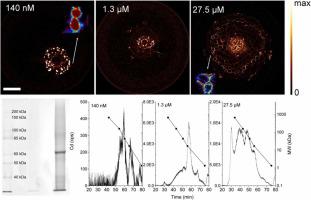Journal of Hazardous Materials ( IF 13.6 ) Pub Date : 2022-09-24 , DOI: 10.1016/j.jhazmat.2022.130062 Elisa Andresen 1 , Isvett Josefina Flores-Sanchez 1 , Dennis Brückner 2 , Syed Nadeem Hussain Bokhari 1 , Gerald Falkenberg 2 , Hendrik Küpper 3

|
Soybean (Glycine max (L.) Merr.) plants were exposed to various Cd concentrations from background and low non-toxic (0.5–50 nM) via sublethally toxic (< 550 nM) to highly, ultimately lethally toxic (3 µM) concentrations. Plants were cultivated hydroponically for 10 weeks until pod development stage of the control plants. The threshold and mechanism of sublethal Cd toxicity was investigated by metabolomics and metalloproteomics (HPLC-ICP-MS) measuring metal binding to proteins in the harvested roots. Spatial distribution of Cd was revealed by µXRF-CT. Specific binding of Cd to proteins already at 50 nM Cd revealed the likely high-affinity protein binding targets in roots, identified by protein purification from natural abundance. This revealed allantoinase, aquaporins, peroxidases and protein disulfide isomerase as the most likely high-affinity targets of Cd binding. Cd was deposited in cortex cell vacuoles at sublethal and bound to the cell walls of the outer cortex and the vascular bundle at lethal Cd. Cd binding to proteins likely inhibits them, and possibly induces detoxification mechanisms, as verified by metabolomics: allantoic acid and allantoate increased due to sublethal Cd toxicity. Changes of the Cd binding pattern indicated a detoxification strategy at lower Cd, but saturated binding sites at higher Cd concentrations.
中文翻译:

大豆根中的亚致死和致死 Cd 毒性特别影响代谢组、Cd 与蛋白质的结合以及 Cd 的细胞分布
大豆(大豆(L.) Merr.) 植物暴露于从背景和低无毒 (0.5–50 nM) 到亚致死毒性 (< 550 nM) 到高度最终致死毒性 (3 µM) 浓度的各种 Cd 浓度。将植物水培培养10周,直到对照植物的豆荚发育阶段。通过代谢组学和金属蛋白质组学 (HPLC-ICP-MS) 测量金属与收获根中蛋白质的结合,研究了亚致死 Cd 毒性的阈值和机制。µXRF-CT 揭示了 Cd 的空间分布。Cd 与已经在 50 nM Cd 的蛋白质的特异性结合揭示了根中可能的高亲和力蛋白质结合目标,通过从天然丰度中纯化蛋白质来确定。这揭示了尿囊素酶、水通道蛋白、过氧化物酶和蛋白质二硫键异构酶是最可能与 Cd 结合的高亲和力靶标。Cd 在亚致死时沉积在皮层细胞液泡中,并在致死 Cd 时与外皮层的细胞壁和维管束结合。Cd 与蛋白质的结合可能会抑制它们,并可能诱导解毒机制,正如代谢组学所证实的那样:由于亚致死 Cd 毒性,尿囊酸和尿囊酸增加。Cd 结合模式的变化表明在较低 Cd 下的解毒策略,但在较高 Cd 浓度下饱和结合位点。由于亚致死镉毒性,尿囊酸和尿囊酸增加。Cd 结合模式的变化表明在较低 Cd 下的解毒策略,但在较高 Cd 浓度下饱和结合位点。由于亚致死镉毒性,尿囊酸和尿囊酸增加。Cd 结合模式的变化表明在较低 Cd 下的解毒策略,但在较高 Cd 浓度下饱和结合位点。



























 京公网安备 11010802027423号
京公网安备 11010802027423号